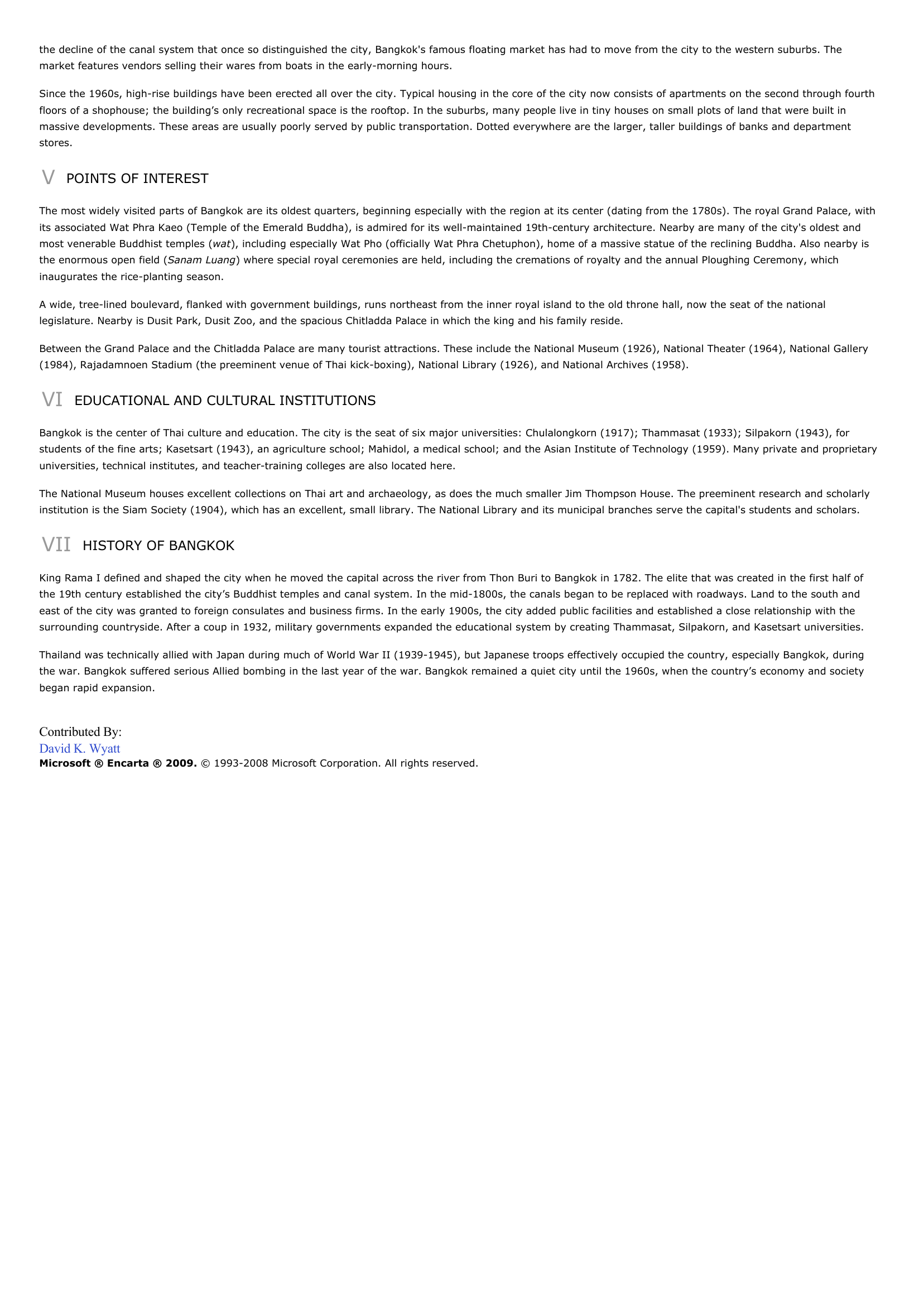Bangkok - geography.
Publié le 04/05/2013

Extrait du document
«
the decline of the canal system that once so distinguished the city, Bangkok's famous floating market has had to move from the city to the western suburbs.
Themarket features vendors selling their wares from boats in the early-morning hours.
Since the 1960s, high-rise buildings have been erected all over the city.
Typical housing in the core of the city now consists of apartments on the second through fourthfloors of a shophouse; the building’s only recreational space is the rooftop.
In the suburbs, many people live in tiny houses on small plots of land that were built inmassive developments.
These areas are usually poorly served by public transportation.
Dotted everywhere are the larger, taller buildings of banks and departmentstores.
V POINTS OF INTEREST
The most widely visited parts of Bangkok are its oldest quarters, beginning especially with the region at its center (dating from the 1780s).
The royal Grand Palace, withits associated Wat Phra Kaeo (Temple of the Emerald Buddha), is admired for its well-maintained 19th-century architecture.
Nearby are many of the city's oldest andmost venerable Buddhist temples ( wat), including especially Wat Pho (officially Wat Phra Chetuphon), home of a massive statue of the reclining Buddha.
Also nearby is the enormous open field ( Sanam Luang ) where special royal ceremonies are held, including the cremations of royalty and the annual Ploughing Ceremony, which inaugurates the rice-planting season.
A wide, tree-lined boulevard, flanked with government buildings, runs northeast from the inner royal island to the old throne hall, now the seat of the nationallegislature.
Nearby is Dusit Park, Dusit Zoo, and the spacious Chitladda Palace in which the king and his family reside.
Between the Grand Palace and the Chitladda Palace are many tourist attractions.
These include the National Museum (1926), National Theater (1964), National Gallery(1984), Rajadamnoen Stadium (the preeminent venue of Thai kick-boxing), National Library (1926), and National Archives (1958).
VI EDUCATIONAL AND CULTURAL INSTITUTIONS
Bangkok is the center of Thai culture and education.
The city is the seat of six major universities: Chulalongkorn (1917); Thammasat (1933); Silpakorn (1943), forstudents of the fine arts; Kasetsart (1943), an agriculture school; Mahidol, a medical school; and the Asian Institute of Technology (1959).
Many private and proprietaryuniversities, technical institutes, and teacher-training colleges are also located here.
The National Museum houses excellent collections on Thai art and archaeology, as does the much smaller Jim Thompson House.
The preeminent research and scholarlyinstitution is the Siam Society (1904), which has an excellent, small library.
The National Library and its municipal branches serve the capital's students and scholars.
VII HISTORY OF BANGKOK
King Rama I defined and shaped the city when he moved the capital across the river from Thon Buri to Bangkok in 1782.
The elite that was created in the first half ofthe 19th century established the city’s Buddhist temples and canal system.
In the mid-1800s, the canals began to be replaced with roadways.
Land to the south andeast of the city was granted to foreign consulates and business firms.
In the early 1900s, the city added public facilities and established a close relationship with thesurrounding countryside.
After a coup in 1932, military governments expanded the educational system by creating Thammasat, Silpakorn, and Kasetsart universities.
Thailand was technically allied with Japan during much of World War II (1939-1945), but Japanese troops effectively occupied the country, especially Bangkok, duringthe war.
Bangkok suffered serious Allied bombing in the last year of the war.
Bangkok remained a quiet city until the 1960s, when the country’s economy and societybegan rapid expansion.
Contributed By:David K.
WyattMicrosoft ® Encarta ® 2009. © 1993-2008 Microsoft Corporation.
All rights reserved..
»
↓↓↓ APERÇU DU DOCUMENT ↓↓↓
Liens utiles
- Bangkok - geography.
- Script:Bangkok vu du fleuve Chao Phra Ya
- Bangkok - geographie.
- Tokyo - geography.
- Toronto - geography.












